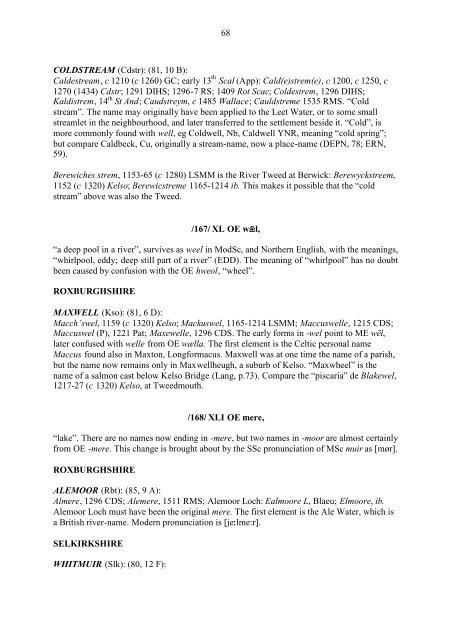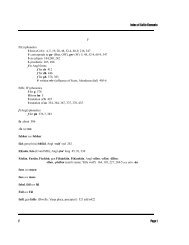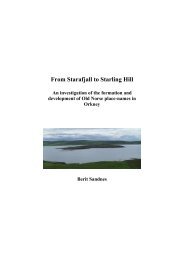May Williamson: The Non-Celtic Place-Names of the Scottish Border ...
May Williamson: The Non-Celtic Place-Names of the Scottish Border ...
May Williamson: The Non-Celtic Place-Names of the Scottish Border ...
Create successful ePaper yourself
Turn your PDF publications into a flip-book with our unique Google optimized e-Paper software.
68<br />
COLDSTREAM (Cdstr): (81, 10 B):<br />
Caldestream, c 1210 (c 1260) GC; early 13 th Scal (App): Cald(e)strem(e), c 1200, c 1250, c<br />
1270 (1434) Cdstr; 1291 DIHS; 1296-7 RS; 1409 Rot Scac; Coldestrem, 1296 DIHS;<br />
Kaldistrem, 14 th St And; Caudstreym, c 1485 Wallace; Cauldstreme 1535 RMS. “Cold<br />
stream”. <strong>The</strong> name may originally have been applied to <strong>the</strong> Leet Water, or to some small<br />
streamlet in <strong>the</strong> neighbourhood, and later transferred to <strong>the</strong> settlement beside it. “Cold”, is<br />
more commonly found with well, eg Coldwell, Nb, Caldwell YNR, meaning “cold spring”;<br />
but compare Caldbeck, Cu, originally a stream-name, now a place-name (DEPN, 78; ERN,<br />
59).<br />
Berewiches strem, 1153-65 (c 1280) LSMM is <strong>the</strong> River Tweed at Berwick: Berewyckstreem,<br />
1152 (c 1320) Kelso; Berewicstreme 1165-1214 ib. This makes it possible that <strong>the</strong> “cold<br />
stream” above was also <strong>the</strong> Tweed.<br />
/167/ XL OE wl,<br />
“a deep pool in a river”, survives as weel in ModSc, and Nor<strong>the</strong>rn English, with <strong>the</strong> meanings,<br />
“whirlpool, eddy; deep still part <strong>of</strong> a river” (EDD). <strong>The</strong> meaning <strong>of</strong> “whirlpool” has no doubt<br />
been caused by confusion with <strong>the</strong> OE hweol, “wheel”.<br />
ROXBURGHSHIRE<br />
MAXWELL (Kso): (81, 6 D):<br />
Macch’swel, 1159 (c 1320) Kelso; Mackuswel, 1165-1214 LSMM; Maccuswelle, 1215 CDS;<br />
Maccuswel (P), 1221 Pat; Maxewelle, 1296 CDS. <strong>The</strong> early forms in -wel point to ME wēl,<br />
later confused with welle from OE wælla. <strong>The</strong> first element is <strong>the</strong> <strong>Celtic</strong> personal name<br />
Maccus found also in Maxton, Longformacus. Maxwell was at one time <strong>the</strong> name <strong>of</strong> a parish,<br />
but <strong>the</strong> name now remains only in Maxwellheugh, a suburb <strong>of</strong> Kelso. “Maxwheel” is <strong>the</strong><br />
name <strong>of</strong> a salmon cast below Kelso Bridge (Lang, p.73). Compare <strong>the</strong> “piscaria” de Blakewel,<br />
1217-27 (c 1320) Kelso, at Tweedmouth.<br />
/168/ XLI OE mere,<br />
“lake”. <strong>The</strong>re are no names now ending in -mere, but two names in -moor are almost certainly<br />
from OE -mere. This change is brought about by <strong>the</strong> SSc pronunciation <strong>of</strong> MSc muir as [mør].<br />
ROXBURGHSHIRE<br />
ALEMOOR (Rbt): (85, 9 A):<br />
Almere, 1296 CDS; Alemere, 1511 RMS; Alemoor Loch: Ealmoore L, Blaeu; Elmoore, ib.<br />
Alemoor Loch must have been <strong>the</strong> original mere. <strong>The</strong> first element is <strong>the</strong> Ale Water, which is<br />
a British river-name. Modern pronunciation is [je;lme:r].<br />
SELKIRKSHIRE<br />
WHITMUIR (Slk): (80, 12 F):




